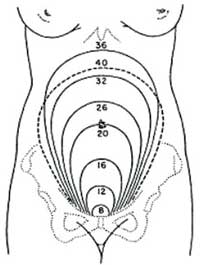
Oestrogen and progesterone are the chief hormones throughout pregnancy
Oestrogen promotes maternal blood flow within the uterus and the placenta.
Progesterone causes some internal structures to increase in size, including the uterus, enabling it to accommodate a full-term baby.
The uterus stretches to accommodate the growing baby, placenta and amniotic fluid. By the time the pregnancy has reached full term, the uterus will have increased to about 5 times its normal size.

At 12 weeks gestation: The upper margin of the body of the uterus (fundus) may be felt through the abdomen above the pubic bone.
At 20 weeks gestation:The fundus can be felt at the height of the woman's umbilicus (belly-button)
At 36 weeks gestation: The size of the uterus reaches its peak
At 40 weeks gestation:The uterus may drop slightly as the fetal head settles into the pelvis, preparing for delivery.
The cervix remains 2.5cm long throughout pregnancy. In late pregnancy, the cervix softens in response to increasing painless contractions of its muscular walls.
The vagina dilates during the second stage of labour, as the baby passes down the birth canal.